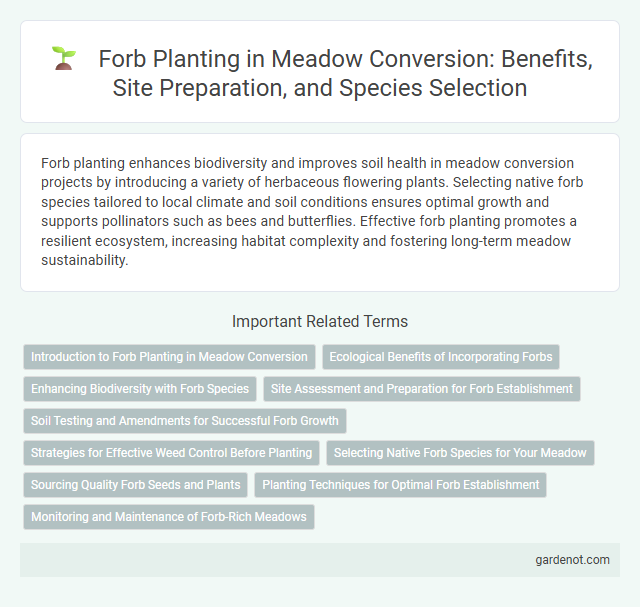Forb planting enhances biodiversity and improves soil health in meadow conversion projects by introducing a variety of herbaceous flowering plants. Selecting native forb species tailored to local climate and soil conditions ensures optimal growth and supports pollinators such as bees and butterflies. Effective forb planting promotes a resilient ecosystem, increasing habitat complexity and fostering long-term meadow sustainability.
Introduction to Forb Planting in Meadow Conversion
Forb planting in meadow conversion enhances biodiversity by introducing broad-leaved herbaceous plants that support pollinators and wildlife. Selecting native forb species adapted to local soil and climate conditions improves ecosystem resilience and promotes habitat diversity. Proper seed mix composition, sowing techniques, and site preparation are critical for establishing a thriving forb-rich meadow.
Ecological Benefits of Incorporating Forbs
Incorporating forbs into meadow conversions significantly enhances biodiversity by providing essential nectar and pollen sources for a wide range of pollinators, including bees, butterflies, and other beneficial insects. Forbs improve soil health through nitrogen fixation and deep root systems that enhance soil aeration and nutrient cycling. Their diverse floral structure supports a variety of bird and insect species, contributing to a balanced and resilient ecosystem.
Enhancing Biodiversity with Forb Species
Forb planting significantly enhances biodiversity by introducing a diverse range of flowering herbaceous plants that provide essential habitats and food sources for pollinators, insects, and wildlife. Species such as oxeye daisy, red clover, and common knapweed increase ecosystem complexity and improve soil health through nitrogen fixation and organic matter contribution. Incorporating a variety of native forb species supports resilient meadow ecosystems and promotes long-term ecological balance.
Site Assessment and Preparation for Forb Establishment
Site assessment for forb planting in meadow conversion involves analyzing soil texture, pH levels, and nutrient availability to ensure optimal growth conditions. Preparing the site requires removing existing vegetation, loosening the soil to enhance aeration, and applying appropriate soil amendments based on site-specific deficiencies. Proper site assessment and preparation directly impact forb establishment success, promoting biodiversity and ecosystem resilience.
Soil Testing and Amendments for Successful Forb Growth
Soil testing is essential for forb planting, providing critical data on pH levels, nutrient content, and organic matter necessary for optimizing growth conditions. Amendments such as lime to adjust pH, phosphorous for root development, and nitrogen to enhance leaf growth improve soil fertility, promoting vigorous forb establishment. Regular monitoring and tailored soil treatments ensure sustained forb health and biodiversity in meadow conversion projects.
Strategies for Effective Weed Control Before Planting
Effective weed control before forb planting in meadow conversion involves a combination of mechanical and chemical strategies to reduce competition and promote healthy establishment. Techniques such as targeted herbicide application, repeated shallow tillage, and the use of cover crops help suppress persistent weed species while preserving soil structure. Monitoring weed seedbanks and timing treatments to pre-empt germination cycles enhance long-term management success in establishing diverse forb populations.
Selecting Native Forb Species for Your Meadow
Selecting native forb species for your meadow conversion ensures optimal adaptation to local soil, climate, and ecological conditions, promoting biodiversity and ecosystem resilience. Prioritize forb species that support local pollinators, such as monarch butterflies and native bees, by providing nectar and habitat throughout the growing season. Incorporating a mix of early, mid, and late-blooming native forbs enhances continuous floral resources and contributes to a vibrant, sustainable meadow ecosystem.
Sourcing Quality Forb Seeds and Plants
Sourcing quality forb seeds and plants is essential for successful meadow conversion, ensuring vibrant biodiversity and ecological balance. Prioritize native species adapted to local soil and climate conditions to enhance plant survival and pollinator support. Certified organic seeds and reputable nurseries offer high germination rates and disease-free plants, optimizing meadow establishment and long-term resilience.
Planting Techniques for Optimal Forb Establishment
Effective forb planting techniques for meadow conversion involve selecting site-appropriate species and preparing the seedbed to ensure good soil-to-seed contact. Using methods such as broadcast seeding followed by light raking or rolling helps enhance seed germination and establishment. Timing seeding during optimal seasonal conditions and ensuring adequate moisture availability further promotes robust forb growth and diversity.
Monitoring and Maintenance of Forb-Rich Meadows
Regular monitoring of forb-rich meadows ensures early detection of invasive species and assesses plant health, promoting biodiversity. Maintenance activities include selective weeding, controlled grazing, and periodic mowing to support forb growth and prevent grass dominance. Data-driven adaptive management optimizes forb establishment, enhancing ecosystem resilience and habitat quality.
Forb planting Infographic

 gardenot.com
gardenot.com